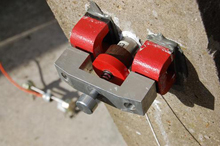The low-cost method could help ensure safe and sturdy infrastructure in disaster prone regions, said the researchers.
The research, published in Earthquake Engineering & Structural Dynamics, was carried out by the academics from universities of Surrey in the UK and Thessaloniki in Greece. It has described a new method of protecting bridge infrastructure using used tyres that may otherwise be sent to landfill. In the UK alone, 50 million tyres are discarded each year.
The researchers looked at how bridges, in particular integral abutment bridges, react to stress and how simple measures could be taken to protect them from wear and tear, as well as in the event of extreme dynamic impacts such as earthquakes.
Lead author Dr Stergios Mitoulis of the University of Surrey said: ““In developing countries especially, there is a need to build bridges using simple and inexpensive methods. This had led to a type of bridge known as an integral bridge becoming increasingly popular which is a simple frame structure with no extra parts such as bearings or expansion joints, it is maintenance-free but has limitations meaning that they can only be used over short lengths. Where the bridge meets the land the soil moves and shifts and in times of stress this can lead to extended damages or collapse. The longer the bridge, the greater the risk of collapse.”
The challenge for the researchers was to find an inexpensive and effective material to bolster bridges, providing support but also providing a buffer able to withstand the force of earthquake situations regardless of the length of the bridge. The team turned to conventional tyres. The waste tyres will be used to create a new product, called the isolator, namely a flexible and elastic layer of reused tyres. This flexible layer will be used to absorb movements, reducing costs of repair.
“As with many of the challenges we face in engineering, the answer came from an unexpectedly simple source,” said Mitoulis. “We were looking for a readily available, cheap and effective material that would keep its cool under pressure. That’s when we thought about the possibility of recycling common tyres and putting to good use a material destined for landfill. We use old tyres to create an aggregate that effectively provides double the performance of conventional designs when movements due to earthquakes or temperature changes are simulated.”
The team said that the new design will eventually allow for safer and sturdier bridges in areas that do not have the means to erect expensive structures that require extensive maintenance.



